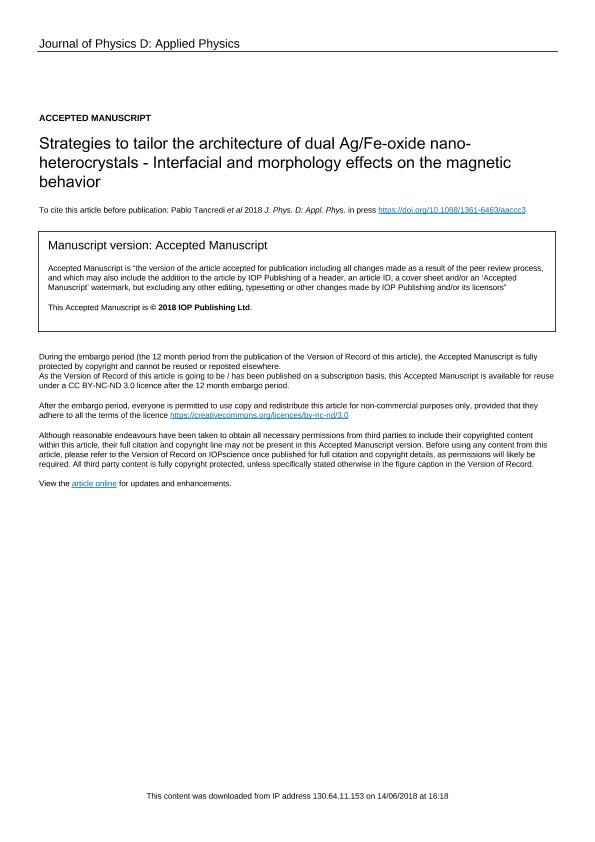Mostrar el registro sencillo del ítem
dc.contributor.author
Tancredi Gentili, Pablo

dc.contributor.author
Moscoso Londoño, Oscar

dc.contributor.author
Rivas Rojas, Patricia Carolina

dc.contributor.author
Wolff, U.
dc.contributor.author
Socolovsky, Leandro Martín

dc.contributor.author
Knobel, M.
dc.contributor.author
Muraca, D.
dc.date.available
2020-01-06T18:43:01Z
dc.date.issued
2018-06
dc.identifier.citation
Tancredi Gentili, Pablo; Moscoso Londoño, Oscar; Rivas Rojas, Patricia Carolina; Wolff, U.; Socolovsky, Leandro Martín; et al.; Strategies to tailor the architecture of dual Ag/Fe-oxide nano-heterocrystals—interfacial and morphology effects on the magnetic behavior; IOP Publishing; Journal of Physics D: Applied Physics; 51; 29; 6-2018; 1-11
dc.identifier.issn
0022-3727
dc.identifier.uri
http://hdl.handle.net/11336/93659
dc.description.abstract
Bifunctional nanostructured architectures have shown appealing properties, since a single entity can combine the diverse properties of its individual constituents. Particularly, by growing Fe-oxide domains over Ag nanoparticles, the plasmonic and superparamagnetic properties can be combined in a single particle. Beyond the multifunctionality of this system, there are several properties that emerge from intrinsic factors, such as: interface and/or morphology. In this study, we present the synthesis protocols to obtain two sets of heterocrystals, each one with different morphology: dimer and flower-like. In addition, the magnetization behavior of these hybrid nano-heterocrystals is investigated and discussed. These nanomaterials were built by a seed assisted heterogeneous nucleation process, carried out in organic solvents of high boiling point, using the same batch of silver nanoparticles with a mean size of 6 nm as seeds, and tuning the electron-donor capacity of the reaction environment at the thermal decomposition of the iron precursor. Ag/Fe3O4 heterocrystals with dimer and flower-like morphologies were obtained. The synthesis protocols for generating these types of nanomaterials are discussed step-by-step. Structural and morphological properties were determined by transmission electron microscopy, x-ray diffraction and x-ray absorption fine structure. DC magnetization results suggest that the silver/magnetite coupling generates an increase of the blocking temperature in comparison to those obtained from pure magnetite. This behavior could be linked to a possible increase in the magnetic anisotropy produced by an additional disorder at the Ag–Fe3O4 interface. The higher interface area of the Ag/Fe3O4 heterocrystals with flower-like architecture leads to a higher blocking temperature and a stronger magnetic anisotropy. These results are supported by AC susceptibility data.
dc.format
application/pdf
dc.language.iso
eng
dc.publisher
IOP Publishing

dc.rights
info:eu-repo/semantics/openAccess
dc.rights.uri
https://creativecommons.org/licenses/by-nc-sa/2.5/ar/
dc.subject
HYBRID NANOSTRUCTURES
dc.subject
INTERFACE EFFECTS
dc.subject
MAGNETIC-PLASMONIC PROPERTIES
dc.subject
SUPERPARAMAGNETISM
dc.subject.classification
Nano-materiales

dc.subject.classification
Nanotecnología

dc.subject.classification
INGENIERÍAS Y TECNOLOGÍAS

dc.subject.classification
Nano-materiales

dc.subject.classification
Nanotecnología

dc.subject.classification
INGENIERÍAS Y TECNOLOGÍAS

dc.title
Strategies to tailor the architecture of dual Ag/Fe-oxide nano-heterocrystals—interfacial and morphology effects on the magnetic behavior
dc.type
info:eu-repo/semantics/article
dc.type
info:ar-repo/semantics/artículo
dc.type
info:eu-repo/semantics/publishedVersion
dc.date.updated
2019-10-22T15:03:14Z
dc.journal.volume
51
dc.journal.number
29
dc.journal.pagination
1-11
dc.journal.pais
Reino Unido

dc.journal.ciudad
Londres
dc.description.fil
Fil: Tancredi Gentili, Pablo. Universidad de Buenos Aires. Facultad de Ingeniería. Departamento de Física. Laboratorio de Sólidos Amorfos; Argentina. Consejo Nacional de Investigaciones Científicas y Técnicas. Oficina de Coordinación Administrativa Houssay. Instituto de Tecnologías y Ciencias de la Ingeniería "Hilario Fernández Long". Universidad de Buenos Aires. Facultad de Ingeniería. Instituto de Tecnologías y Ciencias de la Ingeniería "Hilario Fernández Long"; Argentina
dc.description.fil
Fil: Moscoso Londoño, Oscar. Universidad Autónoma de Manizales; Colombia. Consejo Nacional de Investigaciones Científicas y Técnicas; Argentina. Universidade Estadual de Campinas; Brasil
dc.description.fil
Fil: Rivas Rojas, Patricia Carolina. Consejo Nacional de Investigaciones Científicas y Técnicas. Oficina de Coordinación Administrativa Houssay. Instituto de Tecnologías y Ciencias de la Ingeniería "Hilario Fernández Long". Universidad de Buenos Aires. Facultad de Ingeniería. Instituto de Tecnologías y Ciencias de la Ingeniería "Hilario Fernández Long"; Argentina. Universidad de Buenos Aires. Facultad de Ingeniería. Departamento de Física. Laboratorio de Sólidos Amorfos; Argentina
dc.description.fil
Fil: Wolff, U.. Leibniz Institute for Solid State and Materials Research; Alemania
dc.description.fil
Fil: Socolovsky, Leandro Martín. Consejo Nacional de Investigaciones Científicas y Técnicas. Centro de Investigaciones y Transferencia de Santa Cruz. Universidad Tecnológica Nacional. Facultad Regional Santa Cruz. Centro de Investigaciones y Transferencia de Santa Cruz. Universidad Nacional de la Patagonia Austral. Centro de Investigaciones y Transferencia de Santa Cruz; Argentina
dc.description.fil
Fil: Knobel, M.. Universidade Estadual de Campinas; Brasil
dc.description.fil
Fil: Muraca, D.. Universidade Estadual de Campinas; Brasil
dc.journal.title
Journal of Physics D: Applied Physics

dc.relation.alternativeid
info:eu-repo/semantics/altIdentifier/url/https://iopscience.iop.org/article/10.1088/1361-6463/aaccc3
dc.relation.alternativeid
info:eu-repo/semantics/altIdentifier/doi/http://dx.doi.org/10.1088/1361-6463/aaccc3
Archivos asociados
